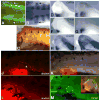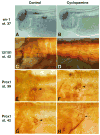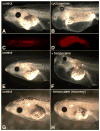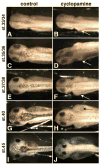Lymph heart musculature is under distinct developmental control from lymphatic endothelium
- PMID: 20067786
- PMCID: PMC2845526
- DOI: 10.1016/j.ydbio.2010.01.002
Lymph heart musculature is under distinct developmental control from lymphatic endothelium
Abstract
Lymph hearts are pulsatile organs, present in lower vertebrates, that function to propel lymph into the venous system. Although they are absent in mammals, the initial veno-lymphatic plexus that forms during mammalian jugular lymph sac development has been described as the vestigial homologue of the nascent stage of ancestral anterior lymph hearts. Despite the widespread presence of lymph hearts among vertebrate species and their unique function, extremely little is known about lymph heart development. We show that Xenopus anterior lymph heart muscle expresses skeletal muscle markers such as myoD and 12/101, rather than cardiac markers. The onset of lymph heart myoblast induction can be visualized by engrailed-1 (en1) staining in anterior trunk somites, which is dependent on Hedgehog (Hh) signaling. In the absence of Hh signaling and upon en1 knockdown, lymph heart muscle fails to develop, despite the normal development of the lymphatic endothelium of the lymph heart, and embryos develop edema. These results suggest a mechanism for the evolutionary transition from anterior lymph hearts to jugular lymph sacs in mammals.
Copyright 2010 Elsevier Inc. All rights reserved.
Figures







Similar articles
-
Hedgehog regulation of superficial slow muscle fibres in Xenopus and the evolution of tetrapod trunk myogenesis.Development. 2004 Jul;131(14):3249-62. doi: 10.1242/dev.01194. Epub 2004 Jun 16. Development. 2004. PMID: 15201218
-
Nuchal edema and venous-lymphatic phenotype disturbance in human fetuses and mouse embryos with aneuploidy.J Soc Gynecol Investig. 2006 Apr;13(3):209-16. doi: 10.1016/j.jsgi.2006.02.003. J Soc Gynecol Investig. 2006. PMID: 16638592
-
Anatomy, Lymphatic System.2023 Mar 6. In: StatPearls [Internet]. Treasure Island (FL): StatPearls Publishing; 2025 Jan–. 2023 Mar 6. In: StatPearls [Internet]. Treasure Island (FL): StatPearls Publishing; 2025 Jan–. PMID: 30020619 Free Books & Documents.
-
Prox1, master regulator of the lymphatic vasculature phenotype.Cell Tissue Res. 2003 Oct;314(1):85-92. doi: 10.1007/s00441-003-0747-8. Epub 2003 Jul 22. Cell Tissue Res. 2003. PMID: 12883994 Review.
-
Eye field specification in Xenopus laevis.Curr Top Dev Biol. 2010;93:29-60. doi: 10.1016/B978-0-12-385044-7.00002-3. Curr Top Dev Biol. 2010. PMID: 20959162 Review.
Cited by
-
Characterisation of Development and Electrophysiological Mechanisms Underlying Rhythmicity of the Avian Lymph Heart.PLoS One. 2016 Dec 8;11(12):e0166428. doi: 10.1371/journal.pone.0166428. eCollection 2016. PLoS One. 2016. PMID: 27930653 Free PMC article.
-
Mechanical forces in lymphatic vascular development and disease.Cell Mol Life Sci. 2013 Nov;70(22):4341-54. doi: 10.1007/s00018-013-1358-5. Epub 2013 May 12. Cell Mol Life Sci. 2013. PMID: 23665871 Free PMC article. Review.
-
A novel perivascular cell population in the zebrafish brain.Elife. 2017 Apr 11;6:e24369. doi: 10.7554/eLife.24369. Elife. 2017. PMID: 28395729 Free PMC article.
-
The Lymphatic System in Zebrafish Heart Development, Regeneration and Disease Modeling.J Cardiovasc Dev Dis. 2021 Feb 19;8(2):21. doi: 10.3390/jcdd8020021. J Cardiovasc Dev Dis. 2021. PMID: 33669620 Free PMC article. Review.
-
Exon capture and bulk segregant analysis: rapid discovery of causative mutations using high-throughput sequencing.BMC Genomics. 2012 Nov 21;13:649. doi: 10.1186/1471-2164-13-649. BMC Genomics. 2012. PMID: 23171430 Free PMC article.
References
-
- Cheng L, Alvares LE, Ahmed MU, El-Hanfy AS, Dietrich S. The epaxial-hypaxial subdivision of the avian somite. Dev Biol. 2004;274:348–69. - PubMed
-
- Cleaver O, Tonissen KF, Saha MS, Krieg PA. Neovascularization of the Xenopus embryo. Dev Dyn. 1997;210:66–77. - PubMed
-
- Currie PD, Ingham PW. Induction of a specific muscle cell type by a hedgehog-like protein in zebrafish. Nature. 1996;382:452–5. - PubMed
-
- Davis CA, Holmyard DP, Millen KJ, Joyner AL. Examining pattern formation in mouse, chicken and frog embryos with an En-specific antiserum. Development. 1991;111:287–98. - PubMed
-
- Devic E, Paquereau L, Vernier P, Knibiehler B, Audigier Y. Expression of a new G protein-coupled receptor X-msr is associated with an endothelial lineage in Xenopus laevis. Mech Dev. 1996;59:129–40. - PubMed
Publication types
MeSH terms
Substances
Grants and funding
LinkOut - more resources
Full Text Sources

